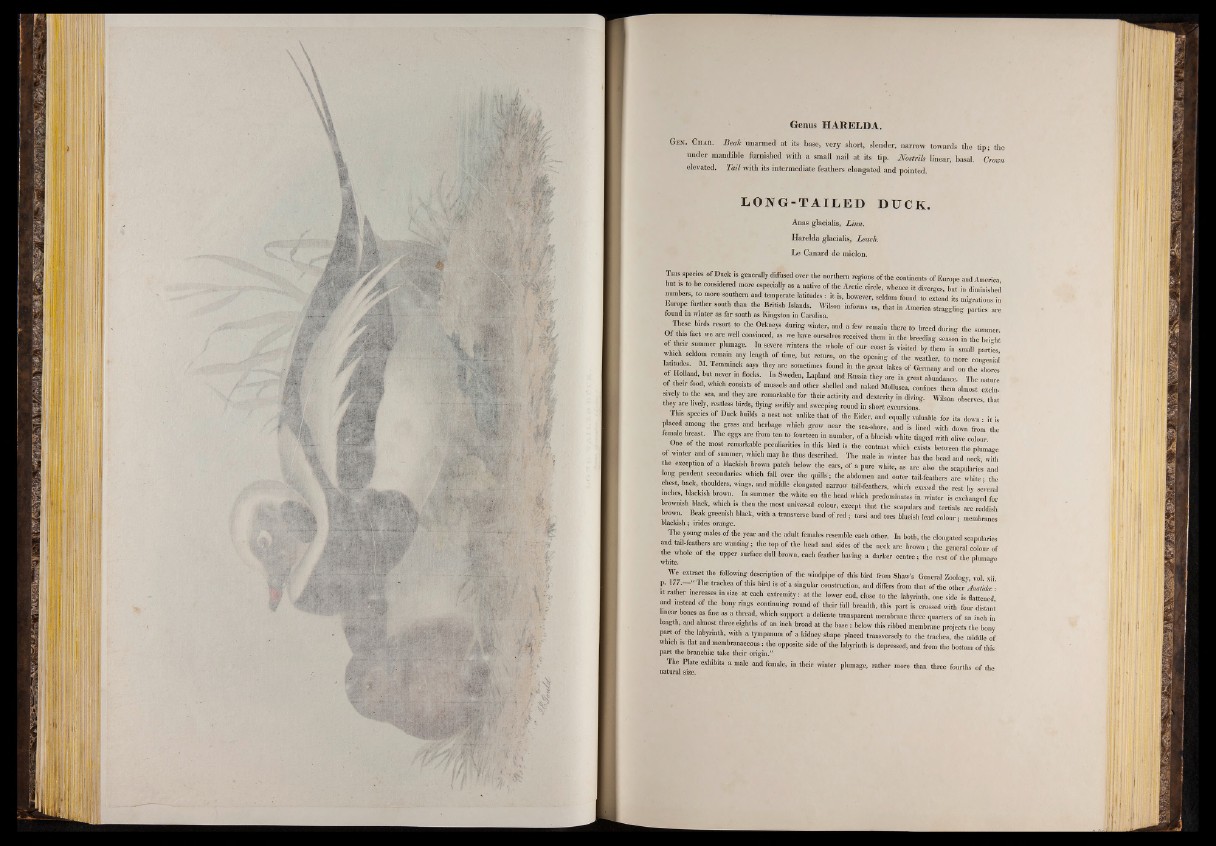
Genus HARELDA.
Gilt. Chab. Beak unarmed at its base, very short, slender, narrow towards the tip; the
under mandible furnished with a small nail at its tip. Nostrils linear, basal. Crmm
elevated. Tail with its intermediate feathers elongated and pointed.
L O N G - T A I L E D DUCK.
Anas glacialis, Linn.
Harelda glacialis, Leach.
Le Canard de miclon.
T his species o f Duck is generally diffused over the northern regions of the continents of Europe and America
but is to be considered more especially as a native of the Arctic circle, whence it diverges, but iu dim;n;. l ,J
numbers, to more southern and temperate latitudes: it is, however, seldom found to extend its migrations in
Europe further south thau the British Islauds. Wilson informs os, that in America straggling parties are
found m winter as far south as Kingston in Carolina.
These birds resort H the Orkneys during winter, and a few remain there to breed during the summer
Of this fact we are well convinced, as we have ourselves received them in the breeding season in the height
of then summer plumage. In severe winters the whole of onr coast is visited by them in small parties
which seldom remain any length of time, but return, on the opening of the weather, to more congenial
latitudes. M. Temminck says they are sometimes found in the great lakes of Germany and on the shores
of Holland but never m flocks. In Sweden, Lapland and Russia they are in great abundauee. The nature
of their food, which consists of mussels and other shelled and naked Mollusea, confines them almost excln-
sively to the sea, and they are remarkable for their activity and dexterity in diving. Wilson observes that
they are lively, restless birds, flying swiftly and sweeping round in short excursions.
This species of Duck builds a nest not unlike that o f the Eider, and equally valuable for its down : it is
placed among the grass and herbage which grow near the seashore, and is lined with down from the’
female breast. The eggs are from ten to fourteen in number, of a blueish white tinged with olive colour
One of the most remarkable peculiarities in this bird is the contrast which exists between the plumage
of winter and of summer, which may be thus described. The male in winter has the head and neck with
the exception of a blackish brown patch below the ears, of a pure white, as are also the acapnlaife and
long pendent secondaries which fall over the quills; the abdomen and outer tail-feathera are white • the
chest, back, shoulders, wings, and middle elongated narrow tail-feathers, which exceed the rest by. several
inches, blackish brown. In summer the white on the head which predominates in winter is exchanged for
brownish black, which is then the most universal colour, except that the scapulars and tertials are reddish
brown Beak greenish black, with a transverse hand of red ; taisi and toes blueish lead colour; membranes
blackish; irides orange.
The young males of tke year and the adult females resemble each other. In both, the elongated scapularies
and tail-feathers are wanting; the top of the head and sides of the neck are brown ; the general colour of
the whole of the upper surface dull brown, each feather having a darker centre; the rest o f the plumage
white. r °
We extract the following description o f the windpipe of this bird from Shawls General Zoology, vol. xii.
p. 177. The trachea of this bird is of a singular construction, and differs from that of the other AmtiitB •
it rather increases in size at each extremity: at the lower end, close to the labyrinth, one side is flattened'
and instead of the bony rings continuing round of their fall breadftjthis part is crossed with four distart
linear bones as fine as a thread, which support a delicate transparent membrane three quartern of an inch in
length and almost three eighths of an inch broad at the base : below this ribbed membrane projects the bony
part of the labyrinth, with a tympanum of a kidney shape placed transversely to the trachea, the middle of
which is flat and membranaceous: the opposite side of the labyrinth is depressed, and from the bottom o f this
part the branchiae take their origin.”
The Plate exhibits a male and female, in their winter plumage, rather more than three fourths of the
natural size.